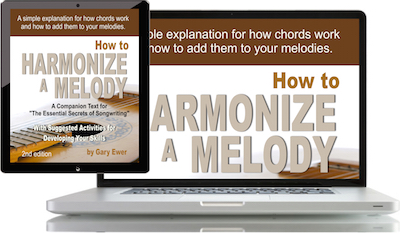One way to make a song stand out and grab attention is to create an instrumental hook, one that may or may not have much to do with the song itself.
One of my favourite examples of how this can work is Stevie Wonder’s “Superstition“. The sung part of the song doesn’t really have a hook that stands out or grabs attention. That’s not a flaw, of course. Many songs don’t get built around an obvious hook.
 “The Essential Secrets of Songwriting” eBook Bundle will take your songwriting further than you’ve ever taken it before. The 10-eBook DELUXE BUNDLE contains “Hooks and Riffs: How They Grab Attention, Make Songs Memorable, and Build Your Fan Base“. Read more..
“The Essential Secrets of Songwriting” eBook Bundle will take your songwriting further than you’ve ever taken it before. The 10-eBook DELUXE BUNDLE contains “Hooks and Riffs: How They Grab Attention, Make Songs Memorable, and Build Your Fan Base“. Read more..
“Superstition” is a great song all on its own, but becomes an even better song because of that catchy clavinet hook that starts the song and then sits underneath the entire tune.
The Eagles’ “Life in the Fast Lane” (Joe Walsh, Glenn Frey and Don Henley) does a similar thing. Though it’s a song with a strong chorus hook all on its own, there are several instrumental riffs and hooks that power up the song even before the first words are sung:
Instrumental riffs and hooks do wonders for supporting your song. It takes everything up a notch and makes your music multidimensional, giving the listener a lot more than just the lead vocal to listen to.
Adding instrumental hooks to your songs takes a bit of careful thought, though. Here are some tips:
- An instrumental hook can, but doesn’t need to, be based on melodic/rhythmic ideas from the lead vocal. You can hear a kind of relationship between the opening clavinet hook and then the vocal line in “Superstition”, but there’s no strong correlation. As long as the hook sounds supportive and interesting, it’s going to work.
- Don’t let an instrumental hook upstage the vocal. In “Superstition”, the fastest notes of the clavinet happen when Stevie is singing a long note, or when he’s not singing at all. There’s a danger in having a song sound too busy if everything is trying to grab listener attention at once.
- Try several instrumental riffs, all of different “intensities,” at different times. “Life In the Fast Lane” is a good example of this. The opening guitar riff is busy, but then backs away to allow a riff with less intensity to take over during the lead vocal.
- Subtlety works. In other words, don’t feel that an instrumental hook needs to be loud or overly obvious. An extremely subtle version of this is Ed Sheeran’s into to “Photograph”, which also serves as connecting material between verses. It’s subtle, because it’s all that’s needed. And it prevents the intro from simply being a strummed guitar.
- Don’t let an instrumental hook mask problems with your song. Songs can have some basic problems that are hard to notice when you’ve added a strong hook. But don’t let a hook be the fix for a song. An example: Let’s say your song is losing energy as it moves from verse to chorus. One solution might be to introduce a strong, up-front instrumental hook in the chorus. But that may just be masking the real problem: your chorus melody is lacking intensity. The real solution might be to rewrite the chorus with higher notes and a climactic moment. Whatever you can do to get your song working properly without a hook will make it ready for the real power that can come by finally adding in the instrumental hook.
 Written by Gary Ewer. Follow Gary on Twitter.
Written by Gary Ewer. Follow Gary on Twitter.
 Gary Ewer’s “How to Harmonize a Melody” is one of 10 songwriting eBooks that comes with “The Essential Secrets of Songwriting” eBook Bundle packages. Read more..
Gary Ewer’s “How to Harmonize a Melody” is one of 10 songwriting eBooks that comes with “The Essential Secrets of Songwriting” eBook Bundle packages. Read more..










